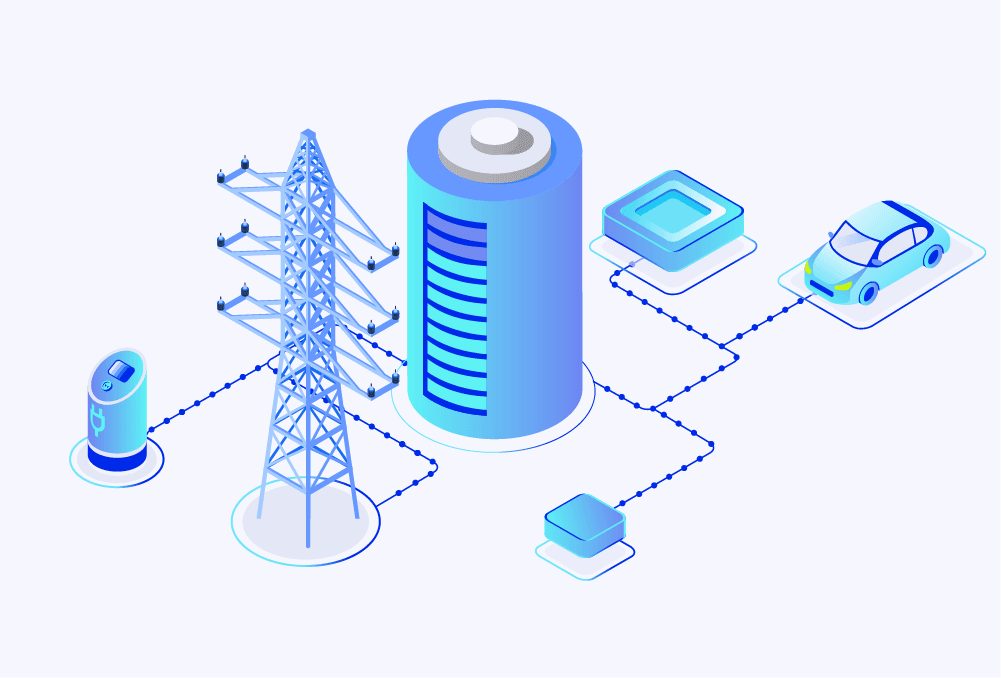Managing EV charging infrastructure today means managing energy systems. CPMS and EMSP platforms are expected to coordinate power distribution across locations, align with grid capacity, and support remote control in real time. Static scheduling or station-level commands are no longer enough.
To meet these demands, platforms need protocols that support forecasting, flexibility, and system-wide communication. The Open Smart Charging Protocol (OSCP) provides that layer. It enables charge point operators and service providers to work with Distribution System Operators (DSOs), adjust load intelligently, and scale charging infrastructure without vendor lock-in.
This article outlines how OSCP fits into a modern CPMS or EMSP architecture, and why it's becoming a foundational part of smart EV charging infrastructure.
Why smart charging needs a protocol like OSCP
OCPP handles communication between a charging station and the management system. But it doesn’t account for the condition of the grid, forecasted capacity, or any external constraints that affect how and when energy should be delivered.
As charging networks expand and power grids become more dynamic, platforms must do more than send start and stop commands. They need to monitor available capacity, adjust charging profiles in real-time, and coordinate behavior across hundreds or thousands of distributed charge points.
This is where smart charging protocols come in. OSCP provides a structured way to share data between energy providers and charging platforms. It introduces a control layer that helps CPMS and EMSP systems distribute energy more efficiently, prevent overloads, and reduce costs during peak hours.
What is Open Smart Charging Protocol (And why it’s different)
The Open Smart Charging Protocol (OSCP) is a communication standard that connects charge point platforms with energy systems. It was developed by the Open Charge Alliance, the same group behind OCPP, to enable real-time coordination between Charge Point Operators (CPOs), Distribution System Operators (DSOs), and energy management systems.
The core function of OSCP is to deliver a 24-hour forecast of local grid capacity. This allows charging platforms to shape energy usage proactively, based on actual grid constraints. Where OCPP handles station-level messaging, OSCP operates at the system level, guiding when and how much energy can be delivered across the entire charging network.
Version 2.0 of OSCP expands on the original by introducing a more flexible domain model and clearer terminology. It also broadens the protocol’s scope beyond electric vehicles, allowing integration with other flexible energy resources like batteries or heat pumps.
The OSCP architecture: Roles and terminology
OSCP introduces a domain model designed to reflect how real-world energy systems interact with charging infrastructure. It defines four key roles:
- Flexibility resource: A device that can consume or produce energy in a controllable way. This includes EVs, battery storage systems, and heat pumps.
- Flexibility Provider: An entity that manages one or more flexibility resources. For most platforms, this means the CPMS or the EMSP acting on behalf of site operators.
- Capacity Provider: A Distribution System Operator (DSO) or Energy Management System (EMS) responsible for managing grid capacity. They provide the 24-hour capacity forecasts that drive OSCP behavior.
- Capacity Optimizer (optional): A service that helps the flexibility provider make better decisions, like an aggregator or energy analytics engine.
Each role is abstracted to support a variety of use cases, from EV fleets to distributed energy systems. This architecture lets platforms operate within a grid-aware context without hardcoding vendor-specific logic.
How OSCP enables dynamic load management
At the core of OSCP is its ability to share a 24-hour forecast of available grid capacity. This forecast is sent from the Capacity Provider (typically a DSO or EMS) to the Flexibility Provider (the CPMS or EMSP). The data is time-based and includes specific limits on how much energy can be consumed or fed back into the grid in each interval.
These forecasts come in five types:
- Consumption Capacity (CC) – the maximum energy that can be consumed in a given period.
- Generation Capacity (GC) – the maximum energy that can be fed back to the grid.
- Fallback Consumption (FC) and Fallback Generation (FGC) – baseline limits used if the connection to the Capacity Provider is lost.
- Optimum (O) – the ideal amount of energy to use or return, based on current grid conditions.
With this information, the CPMS can shape charging schedules, delay or reduce load when needed, and prioritize charging sessions based on available capacity. This supports real-time demand balancing, prevents grid overloads, and allows platforms to integrate with demand response programs.
Real-time communication between systems
OSCP isn’t just about passive forecasting. It also enables active, real-time communication between the Flexibility Provider (e.g., CPMS or EMSP) and the Capacity Provider (e.g., DSO or EMS). This allows the system to respond to actual conditions as they change.
When the Flexibility Provider anticipates a need to exceed the forecasted limits, such as increased charging demand at a site, it can send an AdjustGroupCapacityForecast request. The Capacity Provider can respond in one of two ways:
- Approve the request, allowing the additional load and updating the capacity forecast accordingly.
- Reject the request, returning a GroupCapacityComplianceError, which signals that no extra capacity is available.
This mechanism gives platforms a structured way to negotiate resources while maintaining grid stability and compliance. It also supports more intelligent scheduling, especially in scenarios involving high load variability, fleet coordination, or sites with mixed charging hardware.
Open protocols and hardware interoperability
OSCP was designed to operate alongside protocols like OCPP and OCPI, not replace them. It fills a gap by introducing system-wide energy coordination without restricting hardware or backend choices.
For CPMS and EMSP platforms, this means OSCP can be implemented across diverse infrastructure without needing to standardize on a single hardware vendor. As long as the charging stations support OCPP and the backend supports OSCP, energy coordination is possible at scale.
This flexibility removes vendor lock-in. It allows providers to add new stations, support mixed manufacturers, and adapt infrastructure to specific site requirements without compatibility issues. For multi-country, multi-site networks, it helps to build a comprehensive operational strategy.
OSCP also supports seamless integration with other systems, including battery storage, renewables, and building energy management platforms, giving developers room to build smarter, interconnected ecosystems.
Advanced use cases for smart charging providers
With OSCP in place, charging platforms gain more than load control, they unlock new service capabilities tied to grid participation and operational efficiency.
1. Demand response participation
Service providers can align charging activity with utility programs by reducing or shifting load during high-demand events. OSCP allows precise coordination with Distribution System Operators (DSOs) to meet these requirements.
2. Off-peak electric vehicle charging optimization
By combining grid forecasts with pricing signals, platforms can steer charging to off-peak hours. This reduces operational costs and can be passed on as lower rates to end users.
3. Vehicle-to-Grid (V2G) integration
With OSCP 2.0’s expanded scope, platforms can support bidirectional energy flow. This includes feeding energy from EVs or batteries back to the grid when capacity allows.
4. Renewable energy alignment
Charging activity can be aligned with periods of excess solar or wind power generation, improving utilization and supporting cleaner energy distribution.
These use cases turn charging infrastructure into active grid assets, not just endpoints.
Why OSCP is future-proof for the EV charging industry
As EV charging networks expand and the energy landscape becomes more decentralized, protocols that only handle station-level control fall short. OSCP addresses this by embedding grid awareness, flexibility, and sustainable energy use into the charging process.
Its architecture is designed to evolve with the industry. OSCP 2.0 already supports integration with broader energy systems beyond EVs, including battery storage, heat pumps, and renewable energy sources. This makes it suitable for multi-resource coordination and smart building use cases.
The protocol’s open design also ensures ongoing interoperability. It doesn’t lock platforms into specific technologies or vendors, and it works alongside existing standards like OCPP, OCPI, and ISO 15118.
By aligning with how DSOs and EMSs operate, OSCP positions CPMS and EMSP platforms to stay compliant, competitive, and grid-ready as regulatory and infrastructure demands increase.
Getting started with OSCP implementation
For CPMS and EMSP teams, adopting OSCP starts with understanding where the protocol fits within your platform architecture. OSCP doesn’t replace OCPP or OCPI. Instead, it adds a forecasting and coordination layer that connects your system to DSOs, energy management systems, or site-level controllers.
The specification is available through the Open Charge Alliance. It includes definitions for roles, message structures, security requirements, and data exchange formats. Version 2.0 is the recommended starting point due to its broader system compatibility and improved terminology.
Integration typically involves:
- Mapping OSCP roles to your platform logic (e.g. flexibility provider = CPMS backend)
- Implementing support for receiving and responding to grid capacity forecasts
- Managing charging profiles based on available capacity
- Enabling optional communication with capacity optimizers or aggregators
If you're building a CPMS or EMSP platform and looking to implement OSCP, Solidstudio can help with system design, backend integration, and protocol compliance.
Smarter charging starts at the system level
Managing EV charging infrastructure is no longer just about uptime and connectors. It's about system-wide control, and adapting to grid conditions, scaling without vendor friction, and making your platform ready for what energy management will look like next year, not last year.
The Open Smart Charging Protocol (OSCP) gives CPMS and EMSP platforms the tools to operate with that level of control. It brings energy forecasting, load shaping, and grid alignment into the software layer, where it belongs.
If you're building a platform that needs to support dynamic load management, V2G, or integration with DSOs, we can help. Solidstudio works with EV charging providers to implement open protocols like OSCP, design scalable backend architecture, and deliver systems that are ready for both today’s infrastructure and tomorrow’s requirements.
Let’s talk. Book a consultation now!

